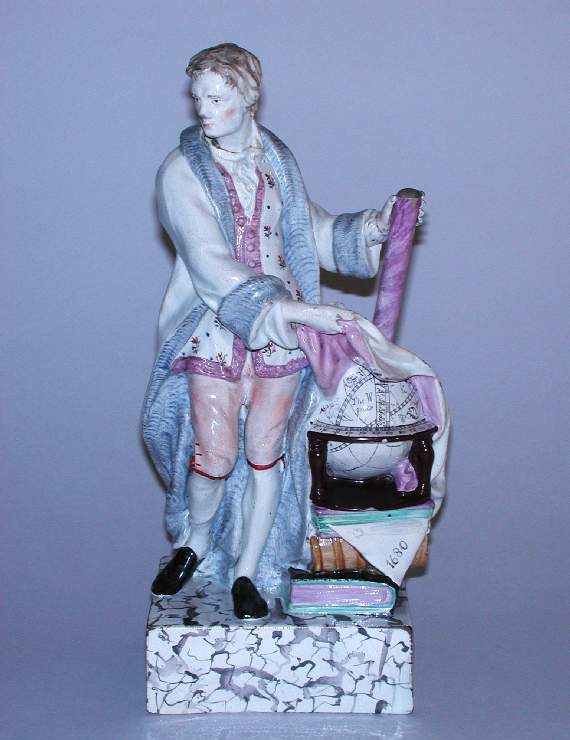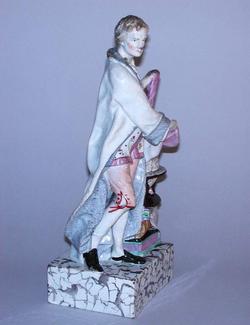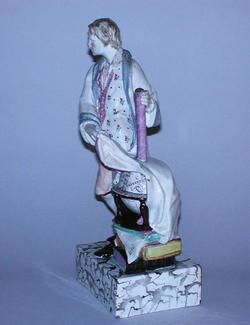Current Location: In storage
Titles
Sir Isaac Newton (1642-1727)
Maker(s)
Production:
Wood, Ralph II
(Probably)
Entities
Categories
Description
Lead-glazed earthenware figure of Sir Isaac Newton standing beside a pile of books and a globe, painted in polychrome enamels
Pale cream earthenware, moulded, covered with slightly blue tinted lead-glaze, and painted in greyish-blue, pale green, yellow, flesh pink, lilac, salmon-pink, red, pale and dark brown, grey and black enamels. The figure is supported on a deep-sided almost square base decorated to resemble black and grey marble. It is hollow underneath and has a large ventilation hole to right of centre, and another in the side of the back wall. Newton stands beside a pile of three books which supports a celestial globe partially covered by a cloth. His weight is on his left leg and his right knee is relaxed so that the foot is behind him. His head is turned to his right. In his left hand he supports a telescope whose lower end rests on the globe, and in his right he holds up the cloth which covers the celestial globe. A piece of paper with a comet in relief, and the date '1680' impressed and painted in black protrudes from the uppermost book. Newton has short brown hair, and wears a white waistcoat with red and black floral sprigs and black spots, lilac borders and buttons, a long white morning gown with greyish-blue fur lining, salmon-pink breeches with red buttons and ties at the knees, white stockings, and black shoes. The telescope and the lining of the cloth over the globe are lilac. The ecliptic, the other markings on the globe, and the degrees around it are in black, and its stand is dark brown. The lowest book is pale green and lilac with a black binding; the next has a brown binding and yellow edges, and the uppermost is pale green and lilac.
Notes
History note: Given by Colonel and Mrs W.D. Dickson of Bournemouth on 2 November 1918 to Dr Glaisher, FRS, Trinity College, Cambridge, for his birthday on 5 November
Legal notes
Dr J. W. L. Glaisher Bequest
Measurements and weight
Height: 30.7 cm
Width: 15 cm
Acquisition and important dates
Method of acquisition: Bequeathed
(1928-12-07)
by
Glaisher, J. W. L., Dr
Dating
18th Century, Late
George III
Circa
1790
-
1795
Note
The extremely bright Great Comet of 1680 was discovered on 14 November by a German astronomer, Gottfried Kirch, in Coburg. It was the first comet to be identified using a telescope. Isaac Newton in 'Principia' (1687), applied his theory of gravitation to show that the 1680 comet moved in an elliptical, almost parabolic orbit round the sun. In England it became known as 'Newton's Comet', although John Flamstead's observations of the comet had played a significant part in enabling Newton to reach his conclusions.
This figure is attributed to Ralph Wood II's factory in Burslem on the basis of examples marked 'Ra. Wood/Burslem' and with the model number '137'. It might also have been made after his death in 1795 when his son, Ralph Wood III, took over the factory and ran it until his death in 1801. The figure of Newton was a companion to a figure of Chaucer (see C. 883-1928).
People, subjects and objects depicted
Components of the work
Decoration
composed of
enamel
( greyish-blue, pale green, yellow, flesh pink, lilac, salmon-pink, red, pale and dark brown, grey and black enamels)
Surface
composed of
lead-glaze
Base
Depth 10 cm
Width 12.5 cm
Materials used in production
Earthenware
Techniques used in production
Moulding
Inscription or legends present
Inscription present: rectangular white paper stick-on label
- Text: C5479/£7/0/- hand-written, FENTON & SONS,/11, New Oxford St.,/London. printed
- Location: On inside of base at front
- Method of creation: Printed and hand-written in black
- Type: Label
Inscription present: rectangular white paper label with cut corners at the top and dark blue line round all but the lower edge; r of Novr is raised
- Text: 4524/statuette of/Sir Isaac Newton/by Ralph Wood/Given to me by/Col. & Mrs Dickson/Novr.2.1918
- Location: On inside of base at the back
- Method of creation: Hand-written in black ink
- Type: Label
Inscription present: semi-circular white stick-on label
- Text: 12 in/30.5 cm.
- Location: On viewer's left inside wall of base
- Method of creation: Hand-written in black ink
- Type: Label
References and bibliographic entries
Identification numbers
Accession number: C.885-1928
Primary reference Number: 76288
Old object number: 4524
Stable URI
Audit data
Created: Saturday 6 August 2011
Updated: Tuesday 30 April 2024
Last processed: Tuesday 15 July 2025
Associated departments & institutions
Owner or interested party:
The Fitzwilliam Museum
Associated department:
Applied Arts







